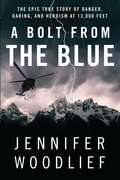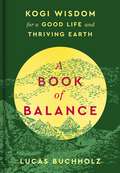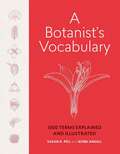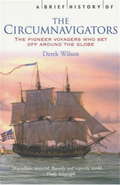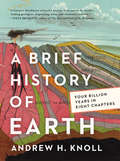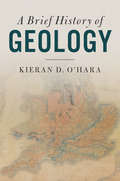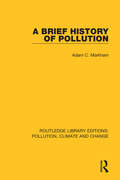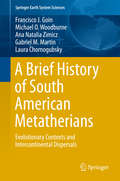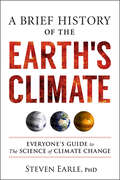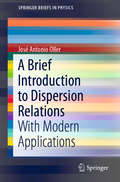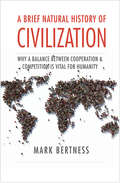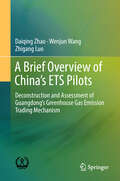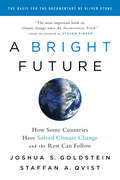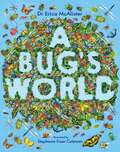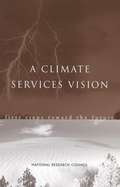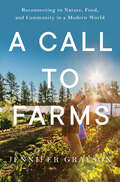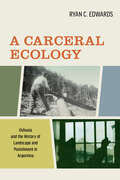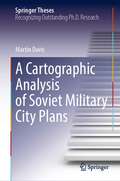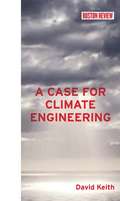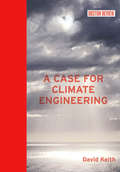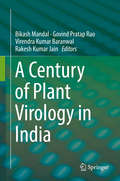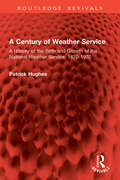- Table View
- List View
A Bolt from the Blue: The Epic True Story of Danger, Daring, and Heroism at 13,000 Feet
by Jennifer WoodliefFIVE INJURED CLIMBERS. TEN SEASONED RANGERS. ONE IMPOSSIBLE RESCUE. On the afternoon of July 26, 2003, six vacationing mountain climbers ascended the peak of the Grand Teton in Jackson Hole, Wyoming. Rain and colliding air currents blew in, and soon a massive electrical charge began to build. As the group began to retreat from its location, a colossal lightning bolt struck and pounded through the body of every climber. One of the six died instantly, one lay critically injured next to her body, and four dangled perilously into the chasm below. In riveting, page-turning prose, veteran journalist Jennifer Woodlief tells the story of the climb, the arrival of the storm, and the unprecedented rescue by the Jenny Lake Rangers, one of the most experienced climbing search-and-rescue teams in the country. Against the dramatic landscape of the Teton Range, Woodlief brings to life the grueling task of the rangers, a band of colorful characters who tackle one of the riskiest, most physically demanding jobs in the world. By turns terrifying and exhilarating, A Bolt from the Blue is both a testament to human courage and an astonishing journey into one of history’s most dangerous mountain rescues.
A Book of Balance: Kogi Wisdom for a Good Life and Thriving Earth
by Lucas BuchholzWe all need help centering ourselves to serve ourselves and our world. In this small, beautiful book, the Kogi—a remote and ancient tribe in the mountains of Colombia--offer their learnings. They pose nine thought-provoking questions to help us live harmoniously with the earth and in turn find happiness and purpose in every moment.“Just as we are both sitting here and talking, this is how we can live well. All of this you will write in the book.”—Mama Jose Gabriel, a spiritual guide of the Kogi tribe, to author Lucas BuchholzFor centuries, the Kogi have lived in seclusion in Colombia’s remote Sierra Nevadas, known as “the heart of the world.” But in recent years, concerned by the environmental degradation they have experienced in their villages and forests, a few emissaries from the tribe emerged to bring an urgent and loving message to the West—advice on how to live in harmony with the earth.Buchholz was invited to their home to receive and transcribe this message. A Book of Balance takes us on a journey into a startlingly beautiful landscape and into a sacred space: the traditional fireside circle held regularly by the tribe. In this circle, members consider key questions essential to their community.In this slim volume of spiritual introspection, they ask us to share in their practice, posing nine questions that focus our minds and hearts on who we are, who we can become.Throughout we hear the words of the Kogi elders, wisdom that offers revelations, inspiration, and direction for our everyday lives.A beautiful book to own, to share with friends, and discuss in community.
A Botanist's Vocabulary: 1300 Terms Explained and Illustrated (Science for Gardeners)
by Susan K. Pell and Bobbi AngellFor anyone looking for a deeper appreciation of the wonderful world of plants! Gardeners are inherently curious. They make note of a plant label in a botanical garden and then go home to learn more. They pick up fallen blossoms to examine them closer. They spend hours reading plant catalogs. But they are often unable to accurately name or describe their discoveries. A Botanist’s Vocabulary gives gardeners and naturalists a better understanding of what they see and a way to categorize and organize the natural world in which they are so intimately involved. Through concise definitions and detailed black and white illustrations, it defines 1300 words commonly used by botanists, naturalists, and gardeners to describe plants.
A Brief History of Circumnavigators
by Derek Wilson"Going round the world" is an idea that has excited people ever since it was realized that the earth was a sphere. The appeal has something to do with encompassing all the known environment and exploring the unknown, not only on the surface of the planet but within the spirit of the explorer. The story of circumnavigation is thus a long saga of human adventure, travel and discovery. Beginning with the fateful day in 1521 when Ferdinand Magellan was speared to death on Mactan and Juan de Elcano took up the challenge of bringing his surviving companions home, the story continues through four centuries crammed with astonishing exploits by men and women of many nations. Some of the names that feature are well-known, others less so.
A Brief History of Circumnavigators (Brief Histories)
by Mr Derek Wilson"Going round the world" is an idea that has excited people ever since it was realized that the earth was a sphere. The appeal has something to do with encompassing all the known environment and exploring the unknown, not only on the surface of the planet but within the spirit of the explorer. The story of circumnavigation is thus a long saga of human adventure, travel and discovery. Beginning with the fateful day in 1521 when Ferdinand Magellan was speared to death on Mactan and Juan de Elcano took up the challenge of bringing his surviving companions home, the story continues through four centuries crammed with astonishing exploits by men and women of many nations. Some of the names that feature are well-known, others less so.
A Brief History of Earth: Four Billion Years in Eight Chapters
by Andrew H. Knoll“A sublime chronicle of our planet." –Booklist, STARRED reviewA primer for every Earth resident, by Harvard’s acclaimed geologistHow well do you know the ground beneath your feet? Odds are, where you’re standing was once cooking under a roiling sea of lava, crushed by a towering sheet of ice, rocked by a nearby meteor strike, or perhaps choked by poison gases, drowned beneath ocean, perched atop a mountain range, or roamed by fearsome monsters. Probably most or even all of the above. The story of our home planet and the organisms spread across its surface is far more spectacular than any Hollywood blockbuster, filled with enough plot twists to rival a bestselling thriller. But only recently have we begun to piece together the whole mystery into a coherent narrative. Drawing on his decades of field research and up-to-the-minute understanding of the latest science, renowned geologist Andrew H. Knoll delivers a rigorous yet accessible biography of Earth, charting our home planet's epic 4.6 billion-year story. Placing twenty first-century climate change in deep context, A Brief History of Earth is an indispensable look at where we’ve been and where we’re going.Features original illustrations depicting Earth history and nearly 50 figures (maps, tables, photographs, graphs).
A Brief History of Geology
by Kieran D. O’HaraGeology as a science has a fascinating and controversial history. <P><P>Kieran D. O'Hara's book provides a brief and accessible account of the major events in the history of geology over the last two hundred years, from early theories of Earth structure during the Reformation, through major controversies over the age of the Earth during the Industrial Revolution, to the more recent twentieth-century development of plate tectonic theory, and on to current ideas concerning the Anthropocene. <P>Most chapters include a short 'text box' providing more technical and detailed elaborations on selected topics. The book also includes a history of the geology of the Moon, a topic not normally included in books on the history of geology. The book will appeal to students of Earth science, researchers in geology who wish to learn more about the history of their subject, and general readers interested in the history of science. <P> Places geology in a wider context of the history of science in general, <P> Sixty figures explain historically important diagrams, <P> Includes a history of the geology of the Moon, which is not normally included in books on the history of geology.
A Brief History of Pollution
by Adam C. MarkhamOriginally published in 1994, this book links the distant past with the urgent problems of today, taking the reader on a literary and scientific tour of global pollution from pre-history to the post-industrial age. Ancient problems such as lead poisoning in Rome and water pollution in Mesopotamia provide the background to a discussion of modern catastrophes including the hole in the ozone layer, climate change and the global drinking water crisis. The book chronicles 800 years of pollution in London, charts the growth of environmental activism and spotlights the rise of the consumer society as the driving force behind today’s malaise.
A Brief History of South American Metatherians: Evolutionary Contexts and Intercontinental Dispersals (Springer Earth System Sciences)
by Michael O. Woodburne Francisco J. Goin Ana Natalia Zimicz Gabriel M. Martin Laura ChornogubskyThis book summarizes major aspects of the evolution of South American metatherians, including their epistemologic, phylogenetic, biogeographic, faunal, tectonic, paleoclimatic, and metabolic contexts. A brief overview of the evolution of each major South American lineage ("Ameridelphia", Sparassodonta, Didelphimorphia, Paucituberculata, Microbiotheria, and Polydolopimorphia) is provided. It is argued that due to physiological constraints, metatherian evolution closely followed the conditions imposed by global temperatures. In general terms, during the Paleocene and the early Eocene multiple radiations of metatherian lineages occurred, with many adaptive types exploiting insectivorous, frugivorous, and omnivorous adaptive zones. In turn, a mixture of generalized and specialized types, the latter mainly exploiting carnivorous and granivorous-folivorous adaptive zones, characterized the second half of the Cenozoic. In both periods, climate was the critical driver of their radiation and turnovers.
A Brief History of the Earth's Climate: Everyone's Guide to The Science of Climate Change
by Steven Earle“Give[s] . . . policymakers and concerned citizens a more thorough understanding of climate science and renewed conviction . . . on leaving fossil fuels behind.” —Tom Green, Senior Climate Policy Advisor, David Suzuki FoundationA Brief History of the Earth’s Climate is an accessible guide to the natural evolution of the Earth’s climate over 4.6 billion years, and how and why human-caused global warming is different and much more dangerous.Richly illustrated chapters cover the major historical climate change processes including evolution of the sun, plate motions and continental collisions, volcanic eruptions, changes to major ocean currents, Earth’s orbital variations, sunspot variations, and short-term ocean current cycles. There is also an overview of the implications of the COVID pandemic for climate change. Content includes:Understanding natural geological processes that shaped the climateHow human impacts are now rapidly changing the climateTipping points and the unfolding climate crisisWhat we can do to limit the damage to the planet and ecosystemsCountering climate myths peddled by climate change science deniers.A Brief History of the Earth’s Climate is essential reading for everyone who is looking to understand what drives climate change, counter skeptics and deniers, and take action on the climate emergency.“Earle understands the big climate picture and paints it with exceptional clarity.” —James Hansen, director, Climate Science, Awareness and Solutions, Columbia University Earth InstituteSteven Earle’s innate story-telling ability, coupled with his remarkable talent for making complex scientific information accessible, makes this page-turner a must-read for anyone seeking to understand the Earth’s climate system.” —Andrew Weaver, University of Victoria, lead author, Intergovernmental Panel on Climate Change
A Brief Introduction to Dispersion Relations: With Modern Applications (SpringerBriefs in Physics)
by José Antonio OllerThis text offers a brief introduction to the dispersion relations as an approach to calculate S-matrix elements, a formalism that allows one to take advantage of the analytical structure of scattering amplitudes following the basic principles of unitarity and causality.First, the case of two-body scattering is considered and then its contribution to other processes through final-state interactions is discussed. For two-body scattering amplitudes, the general expression for a partial-wave amplitude is derived in the approximation where the crossed channel dynamics is neglected. This is taken as the starting point for many interesting nonperturbative applications, both in the light and heavy quark sector. Subsequently crossed channel dynamics is introduced within the equations for calculating the partial-wave amplitudes. Some applications based on methods that treat crossed-channel dynamics perturbatively are discussed too.The last part of this introductory treatment is dedicated to the further impact of scattering amplitudes on a variety of processes through final-state interactions. Several possible approaches are discussed such as the Muskhelishvili-Omnes dispersive integral equations and other closed formulae. These different formalisms are then applied in particular to the study of resonances presenting a number of challenging properties. The book ends with a chapter illustrating the use of dispersion relations in the nuclear medium for the evaluation of the energy density in nuclear matter.
A Brief Natural History of Civilization: Why a Balance Between Cooperation and Competition Is Vital to Humanity
by Mark BertnessA compelling evolutionary narrative that reveals how human civilization follows the same ecological rules that shape all life on Earth Offering a bold new understanding of who we are, where we came from, and where we are going, noted ecologist Mark Bertness argues that human beings and their civilization are the products of the same self-organization, evolutionary adaptation, and natural selection processes that have created all other life on Earth. Bertness follows the evolutionary process from the primordial soup of two billion years ago through today, exploring the ways opposing forces of competition and cooperation have led to current assemblages of people, animals, and plants. Bertness’s thoughtful examination of human history from the perspective of natural history provides new insights about why and how civilization developed as it has and explores how humans, as a species, might have to consciously overrule our evolutionary drivers to survive future challenges.
A Brief Overview of China’s ETS Pilots: Deconstruction And Assessment Of Guangdong's Greenhouse Gas Emission Trading Mechanism
by Daiqing Zhao Wenjun Wang Zhigang LuoThis book systematically introduces readers to the framework of China’s ETS pilots, exploring their design and operating process, the current state of the carbon market, and various barriers encountered. To do so, it deconstructs the Guangdong ETS, which is the largest and most representative of China’s seven ETS pilots. The book subsequently describes and evaluates all seven pilots in terms of their efficiency, macro and micro effects, the method involved in the DEA model, the CGE model, and cost-benefit analysis. In turn, in the assessment section it demonstrates how some ETS pilots have failed to control carbon emissions due to inordinately high emissions quotas issued by the local government etc. Further, it argues that ETS should focus on those industries with large emissions and high mitigating potential for the time being, and then gradually expand the scale of its coverage.As China’s national ETS is slated for launch on the basis of the lessons learned from the ETS pilots, the book offers a timely and valuable resource for all those who want to understand and forecast the development of China’s ETS. It includes a wealth of descriptions and explanations of Chinese government policies involving carbon emissions control, making it a unique resource.
A Bright Future: How Some Countries Have Solved Climate Change and the Rest Can Follow
by Steven Pinker Joshua S. Goldstein Staffan A. QvistThe first book to offer a proven, fast, inexpensive, practical way to cut greenhouse gas emissions and prevent catastrophic climate change. As climate change quickly approaches a series of turning points that guarantee disastrous outcomes, a solution is hiding in plain sight. Several countries have already replaced fossil fuels with low-carbon energy sources, and done so rapidly, in one to two decades. By following their methods, we could decarbonize the global economy by midcentury, replacing fossil fuels even while world energy use continues to rise. But so far we have lacked the courage to really try. In this clear-sighted and compelling book, Joshua Goldstein and Staffan Qvist explain how clean energy quickly replaced fossil fuels in such places as Sweden, France, South Korea, and Ontario. Their people enjoyed prosperity and growing energy use in harmony with the natural environment. They didn't do this through personal sacrifice, nor through 100 percent renewables, but by using them in combination with an energy source the Swedes call kärnkraft, hundreds of times safer and cleaner than coal. Clearly written and beautifully illustrated, yet footnoted with extensive technical references, Goldstein and Qvist's book will provide a new touchstone in discussions of climate change. It could spark a shift in world energy policy that, in the words of Steven Pinker's foreword, literally saves the world.
A Bug's World
by Erica McAlisterDid you know that...Flies can help us solve crimes?Spiders can be astronauts?Moths are the ultimate fashion designers?From making our food to keeping the planet clean and solving crimes, bugs come to our rescue every day. Often without us even realising!Discover the extraordinary things that bugs do for us - and how we can look after them too - in this vibrant gift book written by the Natural History Museum's senior entomologist.
A CLIMATE SERVICES VISION: first steps toward the future
by Board on Atmospheric Sciences ClimateA Climate Services Vision: First Steps Toward the Future describes the types of products that should be provided through a climate service; outlines the roles of the public, private, and academic sectors in a climate service; describe fundamental principles that should be followed in the provision of climate services; and describes potential audiences and providers of climate services.
A CRITICAL EXAMINATION OF THE POSITION OF MR. DARWIN'S WORK, "ON THE ORIGIN OF SPECIES,"
by Thomas Henry HuxleyA Critical Examination of the Position of Mr. Darwin's Work, "On the Origin of Species," in Relation to the Complete Theory of the Causes of the Phenomena of Organic Nature Lecture VI. (of VI.), "Lectures to Working Men", at the Museum of Practical Geology, 1863, on Darwin's Work: "Origin of Species"
A Call to Farms: Reconnecting To Nature, Food, And Community In A Modern World
by Jennifer GraysonHope for the future lies with a new generation of regenerative farmers. Within a decade, nearly half of all American farmland will change hands as an older generation of farmers steps aside. In their place, a groundswell of new growers will face numerous challenges, including soil degradation, insufficient income, and investors devouring farmland at a staggering pace. These new farmers are embracing regenerative agriculture—the holistic approach to growing food that restores the soil and biodiversity—in the movement to reclaim our health and the planet’s. But can their efforts help reverse an epidemic of diet-related disease, food inequality, and even climate change? To answer that question and more, award-winning journalist Jennifer Grayson embedded herself in a groundbreaking farmer training program, then embarked on this investigative journey. The diverse array of farmers, graziers, and food activists whom she profiles here are working toward better, more sustainable foodways for all. From a one-acre market garden in Oregon to activists reviving food sovereignty in South Carolina, A Call to Farms tells the captivating story of these new agrarians finding hope and purpose in reconnecting to the land and striving to improve the future of American food.
A Carceral Ecology: Ushuaia and the History of Landscape and Punishment in Argentina
by Ryan C. EdwardsCloser to Antarctica than to Buenos Aires, the port town of Ushuaia, Argentina is home to a national park as well as a museum that is housed in the world’s southernmost prison. Ushuaia’s radial panopticon operated as an experimental hybrid penal colony and penitentiary from 1902 to 1947, designed to revolutionize modern prisons globally. A Carceral Ecology offers the first comprehensive study of this notorious prison and its afterlife, documenting how the Patagonian frontier and timber economy became central to ideas about labor, rehabilitation, and resource management. Mining the records of penologists, naturalists, and inmates, Ryan C. Edwards shows how discipline was tied to forest management, but also how inmates gained situated geographical knowledge and reframed debates on the regeneration of the land and the self. Bringing a new imperative to global prison studies, Edwards asks us to rethink the role of the environment in carceral practices as well as the impact of incarceration on the natural world.
A Cartographic Analysis of Soviet Military City Plans (Springer Theses)
by Martin DavisThe collapse of the Soviet Union has seen the emergence of its unprecedentedly comprehensive global secret military mapping project and the commercial availability of a vast number of detailed topographic maps and city plans at several scales. This thesis provides an in-depth examination of the series of over 2,000 large-scale city plans produced in secret by the Military Topographic Directorate (Военное топографическое управление) of the General Staff between the end of the Second World War and the collapse of the USSR in 1991. After positioning the series in its historical context, the nature and content of the plans are examined in detail. A poststructuralist perspective introduces possibilities to utilise and apply the maps in new contexts, which this thesis facilitates by providing a systematic, empirical analysis of the Soviet map symbology at 1:10,000 and 1:25,000, using new translations of production manuals and a sample of the city plans. A comparative analysis with the current OpenStreetMap symbology indicates scope for Soviet mapping to be used as a valuable supplementary topographic resource in a variety of existing and future global mapping initiatives, including humanitarian crisis mapping. This leads to a conclusion that the relevance and value of Soviet military maps endure in modern applications, both as a source of data and as a means of overcoming contemporary cartographic challenges relating to symbology, design and the handling of large datasets.
A Case for Climate Engineering
by David KeithClimate engineering -- which could slow the pace of global warming by injecting reflective particles into the upper atmosphere -- has emerged in recent years as an extremely controversial technology. And for good reason: it carries unknown risks and it may undermine commitments to conserving energy. Some critics also view it as an immoral human breach of the natural world. The latter objection, David Keith argues in "A Scientist's Case for Climate Engineering," is groundless; we have been using technology to alter our environment for years. But he agrees that there are large issues at stake. A leading scientist long concerned about climate change, Keith offers no na've proposal for an easy fix to what is perhaps the most challenging question of our time; climate engineering is no silver bullet. But he argues that after decades during which very little progress has been made in reducing carbon emissions we must put this technology on the table and consider it responsibly. That doesn't mean we will deploy it, and it doesn't mean that we can abandon efforts to reduce greenhouse gas emissions. But we must understand fully what research needs to be done and how the technology might be designed and used. This book provides a clear and accessible overview of what the costs and risks might be, and how climate engineering might fit into a larger program for managing climate change.
A Case for Climate Engineering (Boston Review Books)
by David KeithA leading scientist argues that we must consider deploying climate engineering technology to slow the pace of global warming. Climate engineering—which could slow the pace of global warming by injecting reflective particles into the upper atmosphere—has emerged in recent years as an extremely controversial technology. And for good reason: it carries unknown risks and it may undermine commitments to conserving energy. Some critics also view it as an immoral human breach of the natural world. The latter objection, David Keith argues in A Scientist's Case for Climate Engineering, is groundless; we have been using technology to alter our environment for years. But he agrees that there are large issues at stake. A leading scientist long concerned about climate change, Keith offers no naïve proposal for an easy fix to what is perhaps the most challenging question of our time; climate engineering is no silver bullet. But he argues that after decades during which very little progress has been made in reducing carbon emissions we must put this technology on the table and consider it responsibly. That doesn't mean we will deploy it, and it doesn't mean that we can abandon efforts to reduce greenhouse gas emissions. But we must understand fully what research needs to be done and how the technology might be designed and used. This book provides a clear and accessible overview of what the costs and risks might be, and how climate engineering might fit into a larger program for managing climate change.
A Centennial History of the Ecological Society of America
by Frank N. EgertonCelebrating its 100th anniversary in 2015, the Ecological Society of America (ESA) is the largest professional society devoted to the science of ecology. A Centennial History of the Ecological Society of America tells the story of ESA's humble beginnings, growing from approximately 100 founding members and a modest publication of a few pages to a m
A Century of Plant Virology in India
by Bikash Mandal Govind Pratap Rao Virendra Kumar Baranwal Rakesh Kumar JainThe book is a compilation of research work carried out on plant viruses during past 100 years in India. Plant viruses are important constraints in Indian agriculture. Tropical and sub-tropical environments and intensive crop cultivation practices ideally favours perpetuation of numerous plant viruses and their vectors in India, which often cause wide spread crop losses. Of all the plant pathogens, studies of plant viruses have received a special attention as they are difficult to manage. A large body of literature has been published on the plant virus research from India during past 100 years; however the information is so far not available in one place. This book provides comprehensive information on the biology, molecular biology, epidemics, crop losses, diagnosis and management of viruses and viroids occurring in India. Description of properties of the viruses are provided in the chapters comprising of different genera such as Allexivirus, Begomovirus, Babuvirus, Badnavirus, Carlavirus, Carmovirus, Cucumovirus, Closterovirus, Ilavirus, Mandrivirus, Potyvirus, Tospovirus, Tungrovirus and Sobemovirus. Virus-vector research related to aphid, thrips and whitefly is discussed. The work on the management aspects of plant viral diseases has been described with reference to the conventional, antiviral and transgenic approaches. Further, the quarantine mechanism developed in India for the exclusion of viruses and vectors has also been included. The book also provides useful information about the capacity building on the research and education on Plant Virology in India. Overall, the book covers a wide range of accounts of research findings and innovations in Plant Virology in India during past 100 years. The book will be a resourceful reference to the students, scientists, agricultural professionals and policy makers.
A Century of Weather Service: A History of the Birth and Growth of the National Weather Service, 1870-1970 (Routledge Revivals)
by Patrick HughesFirst Published in 1970, A Century of Weather Service provides a comprehensive history of the birth and growth of the National Weather Service from 1870 to 1970 in America. It discusses important themes such as coping with disaster; American weather pioneers; a military weather service; The United States Weather Bureau; the air commerce age; weather in war; growth of a global weather service; calculated weather risks; the air we breathe; and one world of weather. The book closes with a chronology of the meteorological milestones of the American weather services from 1644 to 1970.This is an important historical work for students of environmental geography and general readers interested in the topic.
